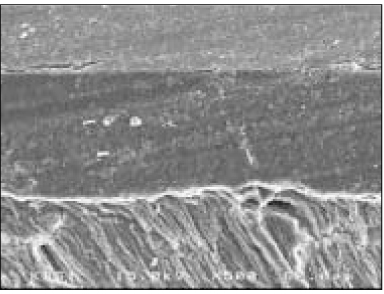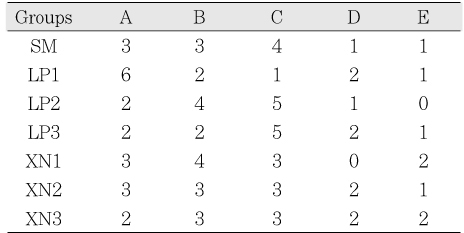Articles
- Page Path
- HOME > Restor Dent Endod > Volume 30(1); 2005 > Article
- Original Article Microtensile bond strength of all-in-one adhesive to caries-affected dentin
- Ji-Deok Moon, Jeong-Kil Park, Bock Hur, Hyeon-Cheol Kim
-
2005;30(1):-57.
DOI: https://doi.org/10.5395/JKACD.2005.30.1.049
Published online: January 31, 2005
Department of Conservative Dentistry, College of Dentistry, Pusan National University, Korea.
- Corresponding author: Hyeon-Cheol Kim. Department of Conservative Dentistry, College of Dentistry, Pusan National University, 1-10 Ami-dong, Seo-gu, Busan, 602-739, Korea. Tel: 82-51-240-7978, golddent@pusan.ac.kr
Copyright © 2005 Korean Academy of Conservative Dentistry
- 714 Views
- 4 Download
Abstract
-
The purpose of this study was to evaluate the effect of multiple application of all-in-one dentin adhesive system on microtensile bond strength to caries-affected dentin.Twenty one extracted human molars with occlusal caries extending into mid-dentin were prepared by grinding the occlusal surface flat. The carious lesions were excavated with the aid of caries detector dye. The following adhesives were applied to caries-affected dentin according to manufacturer's directions; Scotchbond™ Multi-Purpose in SM group, Adper Prompt L-Pop™ 1 coat in LP1 group, 2 coats in LP2 group, 3 coats in LP3 group, Xeno® III 1 coat in XN1 group, 2 coats in XN2 group, and 3 coats in XN3 group. After application of the adhesives, a cylinder of resin-based composite was built up on the occlusal surface. Each tooth was sectioned vertically to obtain the 1 × 1 mm2 sticks. The microtensile bond strength was determined. Each specimen was observed under SEM to examine the failure mode. Data were analyzed with one-way ANOVA.The results of this study were as follows;1. The microtensile bond strength values were; SM (14.38 ± 2.01 MPa), LP1 (9.15 ± 1.81 MPa), LP2 (14.08 ± 1.75 MPa), LP3 (14.06 ± 1.45 MPa), XN1 (13.65 ± 1.95 MPa), XN2 (13.98 ± 1.60 MPa), XN3 (13.88 ± 1.66 MPa). LP1 was significantly lower than the other groups in bond strength (p < 0.05). All groups except LP1 were not significantly different in bond strength (p > 0.05).2. In LP1, there were a higher number of specimens showing adhesive failure. Most specimens of all groups except LP1 showed mixed failure.
- 1. Nakajima M, Ogata M, Okuda M, Tagami J, Sano H, Pashley DH. Bonding to caries-affected dentin using self-etching primers. Am J Dent. 1999;12: 309-314.PubMed
- 2. Nakajima M, Sano H, Zheng L, Tagami J, Pashley DH. Effect of moist vs. dry bonding to normal vs. caries-affected dentin with Scotchbond Multi-Purpose Plus. J Dent Res. 1999;78: 1298-1303.ArticlePubMedPDF
- 3. Yoshiyama M, Tay FR, Doi J, Nishitani Y, Yamada T, Itou K, Carvalho RM, Nakajima M, Pashley DH. Bonding of self-etch and total-etch adhesives to carious dentin. J Dent Res. 2002;81: 556-560.ArticlePubMedPDF
- 4. Yazici AR, Akca T, Ozgunaltay G, Dayangac B. Bond strength of a self-etching adhesive system to caries-affected dentin. Oper Dent. 2004;29: 176-181.PubMed
- 5. Frankenberger R, Kramer N, Petschelt A. Technique sensitivity of dentin bonding: effect of application mistakes on bond strength and marginal adaptation. Oper Dent. 2000;25: 324-330.PubMed
- 6. Croll TP, Berg J. Simplified adhesion of compomers in pediatric dentistry. Quintessence Int. 2000;31: 563-569.PubMed
- 7. Frankenberger R, Kramer N, Oberschachtsiek H, Petschelt A. Dentin bond strength and marginal adaption after NaOCl pre-treatment. Oper Dent. 2000;25: 40-45.PubMed
- 8. Swift EJ Jr, Wilder AD Jr, May KN Jr, Waddell SL. Shear bond strengths of one-bottle dentin adhesives using multiple applications. Oper Dent. 1997;22: 194-199.PubMed
- 9. Fritz UB, Finger WJ. Bonding efficiency of single-bottle enamel/dentin adhesives. Am J Dent. 1999;12: 277-282.PubMed
- 10. Bouillaguet S, Gysi P, Wataha JC, Ciucchi B, Cattani M, Godin C, Meyer JM. Bond strength of composite to dentin using conventional, one-step and self-etching adhesive systems. J Dent. 2001;29: 55-61.ArticlePubMed
- 11. Pashley EL, Agee KA, Pashley DH, Tay FR. Effects of one versus two applications of an unfilled, all-in-one adhesive on dentine bonding. J Dent. 2002;30: 83-90.ArticlePubMed
- 12. Frankenberger R, Perdigao J, Rosa BT, Lopes M. 'Nobottle' vs 'multi-bottle' dentin adhesives-a microtensile bond strength and morphological study. Dent Mater. 2001;17: 373-380.ArticlePubMed
- 13. Sengun A, Unlu N, Ozer F, OztUrk B. Bond strength of five current adhesives to caries-affected dentin. J Oral Rehabil. 2002;29: 777-781.ArticlePubMed
- 14. Kurosaki N, Kubota M, Yamamoto Y, Fusayama T. The effect of etching on the dentin of the clinical cavity floor. Quintessence Int. 1990;21: 87-92.PubMed
- 15. Perdigao J, Swift EJ Jr, Denehy GE, Wefel JS, Donly KJ. In vitro bond strengths and SEM evaluation of dentin bonding systems to different dentin substrates. J Dent Res. 1994;73: 44-55.ArticlePubMedPDF
- 16. Sano H, Shono T, Sonoda H, Takatsu T, Ciucchi B, Carvalho R, Pashley DH. Relationship between surface area for adhesion and tensile bond strength - evaluation of a micro-tensile bond test. Dent Mater. 1994;10: 236-240.ArticlePubMed
- 17. Phrukkanon S, Burrow MF, Tyas MJ. The influence of cross-sectional shape and surface area on the microtensile bond test. Dent Mater. 1998;14: 212-221.ArticlePubMed
- 18. Ceballos L, Camejo DG, Victoria Fuentes M, Osorio R, Toledano M, Carvalho RM, Pashley DH. Microtensile bond strength of total-etch and self-etching adhesives to caries-affected dentine. J Dent. 2003;31: 469-477.ArticlePubMed
- 19. Ai H, Nagai M. Effect of the adhesive layer thickness on the fracture toughness of dental adhesive resins. Dent Mater J. 2000;19: 153-163.ArticlePubMed
- 20. Zheng L, Pereira PN, Nakajima M, Sano H, Tagami J. Relationship between adhesive thickness and microtensile bond strength. Oper Dent. 2001;26: 97-104.PubMed
- 21. Walshaw PR, McComb D. Clinical considerations for optimal dentinal bonding. Quintessence Int. 1996;27: 619-625.PubMed
- 22. Perdigao J, Lambrechts P, Van Meerbeek B, Braem M, Yildiz E, Yucel T, Vanherle G. The interaction of adhesive systems with human dentin. Am J Dent. 1996;9: 167-173.PubMed
- 23. Miyazaki M, Ando S, Hinoura K, Onose H, Moore BK. Influence of filler addition to bonding agents on shear bond strength to bovine dentin. Dent Mater. 1995;11: 234-238.ArticlePubMed
- 24. Gallo JR, Comeaux R, Haines B, Xu X, Burgess JO. Shear bond strength of four filled dentin bonding systems. Oper Dent. 2001;26: 44-47.PubMed
- 25. Marshall GW, Marshall SJ, Kinney JH, Balooch M. The dentin substrate: Structure and properties related to bonding. J Dent. 1997;25: 441-458.ArticlePubMed
- 26. Yoshiyama M, Sano H, Ebusi S, Tagami J, Ciucchi B, Carvalho RM, Jhonson MH, Pashley DH. Regional strength of bonding agents to cervical sclerotic root dentin. J Dent Res. 1996;75: 1404-1413.ArticlePubMedPDF
- 27. Cehreli ZC, Yazici AR, Akca T, Ozgunaltay G. A morphological and micro-tensile bond strength evaluation of a single-bottle adhesive to caries-affected human dentine after four different caries removal techniques. J Dent. 2003;31: 429-435.ArticlePubMed
- 28. Nakajima M, Sano H, Burrow MF, Tagami J, Yoshiyama M, Ebisu S, Ciucchi B, Russell CM, Pashley DH. Tensile bond strength and SEM evaluation of caries-affected dentin using dentin adhesives. J Dent Res. 1995;74: 1679-1688.ArticlePubMedPDF
REFERENCES




Tables & Figures
REFERENCES
Citations












Figure 1
Figure 2
Figure 3
Figure 4
Figure 5
Figure 6
Figure 7
Figure 8
Figure 9
Figure 10
Figure 11
Dentin bonding systems used in this study
Adhesive systems tested in the study and application protocol
Microtensile bond strength (MTBS) (MPa) (mean ± SD)
*: There was significant difference among groups by Scheffe's test (p < 0.05).
Failure mode
Type A : adhesive failure between bonding resin and dentin
Type B : mixed failure (above 50% adhesive failure)
Type C : mixed failure (below 50% adhesive failure)
Type D : cohesive failure in resin
Type E : cohesive failure in dentin
*: There was significant difference among groups by Scheffe's test (p < 0.05).
Type A : adhesive failure between bonding resin and dentin Type B : mixed failure (above 50% adhesive failure) Type C : mixed failure (below 50% adhesive failure) Type D : cohesive failure in resin Type E : cohesive failure in dentin

 KACD
KACD











 ePub Link
ePub Link Cite
Cite

